Scientists from the University of Science and Technology of China have conducted a review of research on the dust-scaling process on PV panels and various water-based cleaning methods.
They were able to establish a relationship between different types of dust scales and water-cleaning parameters. Overall, the team has looked through 250 articles published throughout the world up to 2024.
“Under complex environmental conditions, dust deposition and scaling mechanisms significantly affect the reduction in power generation efficiency,” researcher Long Shi told pv magazine. “The dynamic relationship between dust scaling patterns and water-cleaning parameters under varying weather and pollution conditions remains poorly understood. To effectively address PV dust and scaling issues, it is essential to study the relationship between the dust scaling process and water-cleaning parameters.”
Their analysis of dust scale formation considered dust characteristics and environmental factors. They identified elements, particle size, and surface roughness as key characteristics. Environmental factors included relative humidity, dew, and rainfall across various seasons and geographic environments. Mineral dust, biological dust, and industrial dust form four types of scale under these environmental influences.
The combination of different dust characteristics and environmental factors influences scale formation mechanisms, affecting the scale type.
“The modes of action of dust scale formation include adsorption-condensation, recrystallization, solid bridge, chemical reaction, oily adhesion, chemical bonding, rearrangement, agglomeration, and compaction,” added the researchers. “Dust scale types include approximate laminar scale, localized accumulation scale, island scale, and gully-like laminar scale.”
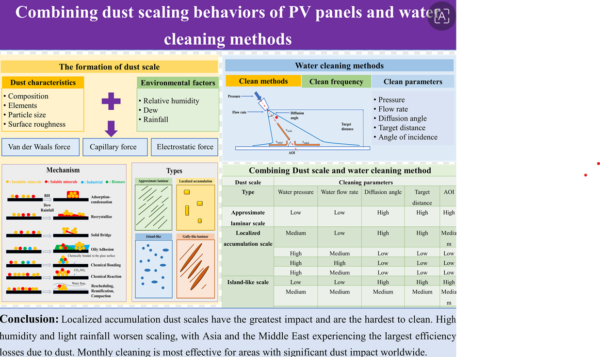
Image: University of Science and Technology of China
The scientists analyzed hundreds of papers to match dust scale types, sources, and characteristics to cleaning parameters. They identified water cleaning parameters such as water pressure, flow rate, diffusion angle, distance from the panel, and angle of incidence (AOI).
Graphical abstract of the research work“Scales formed by single mineral dust have little adhesion and are easily cleaned. Scales containing some biological dust and industrial dust are more challenging to clean,” the researchers said. “For the localized accumulation scale, the island-like scale and the gully-like laminar scale require a higher impact force for effective dislodging. For the large thickness of dust scales, the impact force should be considered first, and for the small thickness of dust scaling, the coverage area of the water flow should be considered.”
Dust from desert, urban, and coastal sources forms a “mud belt” that reduces efficiency and increases thermal risks. Humidity levels between 40% and 80% enhance capillary forces, making dust more likely to cause scaling. Studies indicate that PV efficiency is most affected in Asia, followed by Africa and Oceania, with weekly losses reaching up to 7.84%, 3.03%, and 2.4%, respectively. High dust density regions include North Africa, the Middle East, West Asia, the western United States, Australia, and parts of China and India.
“Pressurized water cleaning improves power generation efficiency by an average of 10.4%,” the academics said. “Weekly water cleaning of PV panels can effectively eliminate dust contamination. The minimum water consumption for aqueous cleaning is 0.31 L/m2, the maximum is 4.95 L/m2, and the average water consumption is 2.1 L/m2.”
They presented their findings in “Combining dust scaling behaviors of PV panels and water cleaning methods,” which was recently published in Renewable and Sustainable Energy Reviews.
This content is protected by copyright and may not be reused. If you want to cooperate with us and would like to reuse some of our content, please contact: editors@pv-magazine.com.
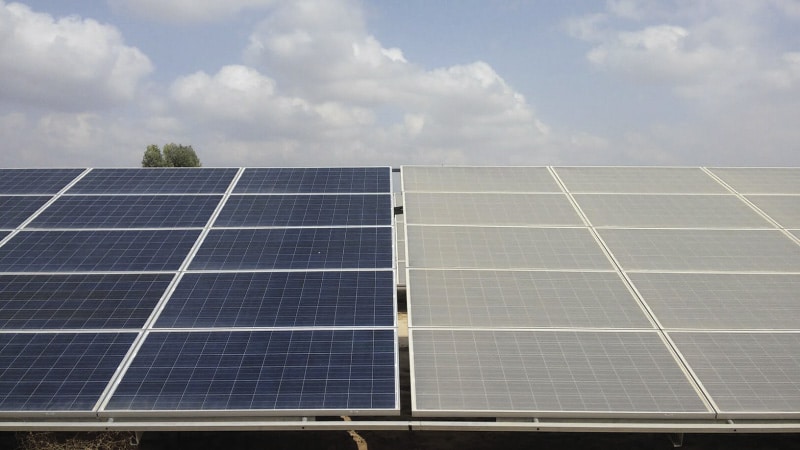




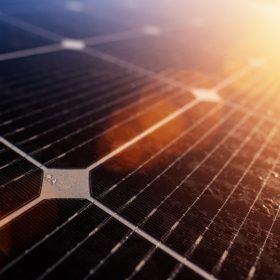
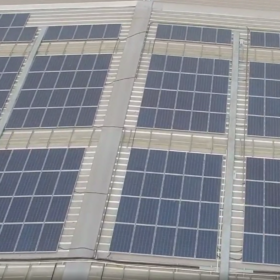
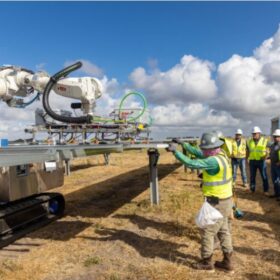
By submitting this form you agree to pv magazine using your data for the purposes of publishing your comment.
Your personal data will only be disclosed or otherwise transmitted to third parties for the purposes of spam filtering or if this is necessary for technical maintenance of the website. Any other transfer to third parties will not take place unless this is justified on the basis of applicable data protection regulations or if pv magazine is legally obliged to do so.
You may revoke this consent at any time with effect for the future, in which case your personal data will be deleted immediately. Otherwise, your data will be deleted if pv magazine has processed your request or the purpose of data storage is fulfilled.
Further information on data privacy can be found in our Data Protection Policy.